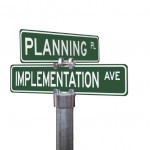Brent Adamson's Blog, page 29
April 2, 2012
5 Ways to Compensate Reps During Onboarding
 Let's face it, getting your compensation plan right is a key factor to ensuring the success of your sales force as a whole. Not only is competitive pay the most important job attribute for attracting and retaining top sales talent, but how compensation plans are designed can also heavily influence how sellers approach important objectives for that year.
Let's face it, getting your compensation plan right is a key factor to ensuring the success of your sales force as a whole. Not only is competitive pay the most important job attribute for attracting and retaining top sales talent, but how compensation plans are designed can also heavily influence how sellers approach important objectives for that year.
That being said, designing a compensation plan that's right for your organization is no easy task—especially when you are determining the base/variable split for new sales talent. Having a well thought out variable pay plan during onboarding is paramount to the success of your new sellers as it can have a tremendous impact on initial productivity. Good variable pay plans for use during onboarding will:
provide sellers with clear expectations and accountability at the beginning of their role.
acclimate them to variable compensation and how it works in nature should it be a new concept to them.
give them an early taste of what successful selling for your organization looks like.
The benefits of a properly designed plan don't stop there—they also promote success in the long-term by providing sellers with the understanding of what they will need to continue doing from an activities standpoint to hit their quotas.
Because some designs are more effective than others on a company-by-company basis, there's no one right answer when it comes to variable pay during onboarding. But recently on the Sales Ops forum, several members shared the following strategies for tackling this design challenge:
Variable pay tied to productivity metrics
Tenured rep incentive plans with reduced targets
Pay 100% commission for 90 days
90-days of guaranteed, non-recoverable pay
Aggressive 90-day MBO's
SEC Members, to read how organizations are using these approaches to pay reps during onboarding, check out our new Tailoring Variable Compensation: Peer Perspectives from Discussions page. In addition to variable pay during onboarding, it covers topics such as aligning rep/manager incentives and commissions for sales people that leave the company. Also be sure to visit our resource center on designing effective compensations plans.
So what does you compensation plan look like for new hires?
March 28, 2012
4 Ways to Make or Break Rep Credibility
 Credibility is a need to have for sales reps – but it's just one of many factors critical to winning a deal. It alone doesn't guarantee success, but without it your chances of winning that account are next to nil.
Credibility is a need to have for sales reps – but it's just one of many factors critical to winning a deal. It alone doesn't guarantee success, but without it your chances of winning that account are next to nil.
So the million dollar question: how exactly do you build credibility in the first place?
Admittedly, part of credibility is simply based on a prospect's perception of your credibility, especially when you haven't yet interacted. Many of our recent member conversations show that personal references and introductions made by mutual contacts help prospects view you as more credible than other suppliers.
While part of this may seem beyond your control, you can directly impact other aspects of credibility-building. We recently spoke with a few corporate buyers to get their perspective on vendor trust and reputation. These conversations revealed a number of key credibility-building factors, mainly:
ATTITUDE: "It's important that the supplier understand my world and is committed to my cause," one buyer stated in a recent conversation. Sellers must have a positive, "we can solve this together" attitude. On the contrary, hard line techniques, such as telling customers the price will go up by 20% if they don't commit within a few days, are a huge turn off. According to the same buyer, that's a sign to him that there was no loss in turning away that business.
PERCEIVED INTENT: According to the buyers we spoke with, perceived intent is vitally important. "Is the supplier self-serving or are they really educating me?" one buyer asked. He told us of an instance where his organization had been overbilled by a supplier. During follow up conversations to clarify the seller's complex billing system, the supplier joked, "where there's mystery, there's margin." While this comment was in jest, it immediately made the buyer doubt the supplier's intentions and ultimately, take his business somewhere else. "If I hadn't pointed out the mistake, would he have? Can I trust someone like that to lead me down the right path in the future?" the buyer asked.
INSIGHTS: Insights are quite powerful and compelling – but can backfire if used incorrectly. "I've had situations where sellers thought they said something insightful when in fact it was not," one buyer we spoke with commented. "They may not have referenced faulty data, but may have drawn the wrong conclusion based on that data – and that's a sign to me that I don't want to do business with them."
CHALLENGING—AT THE RIGHT TIME. One buyer we spoke with commented how the seller constantly pressured him, as the customer, to share proprietary information that they as a company were not yet ready to share. Now the seller probably did not intend to make the customer uncomfortable, but the customer was very concerned about sharing this information with an outsider. While challenging the customer in itself is a good thing, doing so prematurely when you haven't yet achieved that trusted advisor status can make them uneasy and stall, rather than progress the deal.
The bottom line is that trust grows over time. As one customer put it, one wrong move by the seller can undo years of work in an instant, and "the relationship could come tumbling down like a house of cards."
SEC Members, now that you've delved into the buyer mindset, incorporate these ideas into your commercial teaching pitch.
What are your thoughts? What other approaches do you use to build credibility with prospects and customers?
March 27, 2012
Five Movie Characters Fit For Sales
(This post was originally written by Brad Fager of the Customer Contact Council, our sister program for heads of Customer Service. The SEC team has updated it with a sales perspective.)
 Whether you're a true film aficionado or simply enjoy the occasional movie on weekends, everyone remembers certain characters they either identified with or were impressed by. One movie-related thought exercise that interested us recently was speculation about which movie characters would be best suited for jobs within sales organizations. While this is certainly just a fun exercise, it actually does get you thinking about the characteristics that are most desirable for sales reps and managers.
Whether you're a true film aficionado or simply enjoy the occasional movie on weekends, everyone remembers certain characters they either identified with or were impressed by. One movie-related thought exercise that interested us recently was speculation about which movie characters would be best suited for jobs within sales organizations. While this is certainly just a fun exercise, it actually does get you thinking about the characteristics that are most desirable for sales reps and managers.
Here's a list of the top five characters we came up with:
1. Billy Beane (Moneyball): As general manager of a poorly financed baseball team, Billy Beane uses an unorthodox scouting style that puts hard data up against baseball's standard scouting methods. With Billy Beane in your sales organization, you'd have the most effective recruiting system in the industry. He'd throw out the standard hiring playbook and devise a system that would pack your organization with high performing challenger reps.
2. Michael Clayton (Michael Clayton): Known in the movie as "the fixer," Michael Clayton's role is to clean up the messiest legal issues his clients face. In a sales force, the innovative manager assumes the role of a "fixer." Innovative managers help reps to identify obstacles and find new, creative ways to "unstick" stalled deals. He'd be the manager who could put fires out when urgent issues pop up. His cunning ability to stay cool and always have a resolution would lend itself well to a sales manager role.
3. Leigh Anne Tuohy (The Blind Side): Leigh Anne Tuohy is a good-spirited mother figure who nurtures a high school football player who previously had no place to call home. Through her support, he eventually makes it to the NFL. Her ability to identify his individual strengths and skill gaps then help him develop is a classic example of an effective talent development manager and trainer. Leigh Anne would be an asset to your sales organization, helping nurture internal development, and making sure behavioral change sticks.
4. Nick Naylor (Thank You for Smoking): Nick Naylor is a slick and persuasive lobbyist, so if your organization needs reps that can challenge customers, then he's your guy. As the VP of a tobacco lobby, he has the monumental task of advocating for a vilified industry, but he does it and he does it well. In order to take on this role, he challenges consumers' (and anti-smoking advocates) way of thinking, and delivers unique insights. With him on your front line taking control of the buying process and using constructive tension to his advantage, you could convince any customer to buy your products.
5. Tony D'Amato (Any Given Sunday): Our research shows effective coaching has a significant impact on sales team performance, so your organization would be served well by hiring Tony D'Amato. Having provided quite possibly the most motivating speech in movie history, Tony D'Amato would inspire and lead your staff to greatness. Under his leadership, your organization would "either heal now as a team or die as individuals." Now that's motivation!
This is certainly just a short list of characters, so please add who you think would be effective in a sales environment, in the comments section below!
March 26, 2012
Win the Behavior Change "Battle"
 Perhaps this is an image familiar to you: It's been decided that your sales force needs new selling skills and behaviors. A great new sales training program and new sessions have been put into place. It's time for that first session. The facilitator is at the front of the room and the sales reps are all in their seats. You're in the back, enjoying the view. But before anything is said, you feel it; a little anxiety. You spot a few cold looks and evil eyes from reps aimed at the facilitator. You feel confident, but you are increasingly unsure about how this is going to go. And then you see it…the line has been drawn in the sand, with your sales reps on one side and sales leadership and training on the other. Gulp.
Perhaps this is an image familiar to you: It's been decided that your sales force needs new selling skills and behaviors. A great new sales training program and new sessions have been put into place. It's time for that first session. The facilitator is at the front of the room and the sales reps are all in their seats. You're in the back, enjoying the view. But before anything is said, you feel it; a little anxiety. You spot a few cold looks and evil eyes from reps aimed at the facilitator. You feel confident, but you are increasingly unsure about how this is going to go. And then you see it…the line has been drawn in the sand, with your sales reps on one side and sales leadership and training on the other. Gulp.
Sound familiar? Are you thinking, been there done that? Now, this is most likely not happening to everyone, all the time, but it's a common situation we hear from our members. And in today's constantly changing B2B sales environment, the stakes have never been higher to get sales training right. In fact, when we asked sales leaders where they would spend the next dollar if they had one, they put sales training at the top of the list.
This puts exceedingly high expectations on the training programs we are creating for our sales reps. Often times, after a new program, we see the scenario above play out. Or perhaps things go well early, but we fail to see the behavior change long-term. But why? Aren't these the skills needed for future success?
There are two main reasons we don't get the behavior change we invested in:
Failure to Learn: Reps resist learning new skills. Surprised by this one? Probably not. Either reps believe they already "do it right" or they don't believe the new skills will help them.
Failure to Apply: On-the-job barriers hinder application. There are several reasons we see this happen. Day-to-day job tasks just get "in the way". Who's got the time, really? Additionally, managers coach to what they did, rather than to the new skills. Isn't that just easier? Finally, there are always other requests for reps' time that often conflict with training.
Often times, doesn't it feel like the battle is lost before we've even gotten started?
Well, there's good news to share. We can take specific action to have the upper hand in this "behavior change battle" and declare victory or, at least, avoid surrender.
In our time working with SEC members, we've been able to identify the critical principles world class sales development programs adhere to:
Think about development as LONG-TERM, rather than as ad-hoc, single learning events
Individuals attend sessions only RELEVANT to their needs. It's not a one-size fits all approach
Reps must SELF-DISCOVER the need to change behaviors
EQUIP managers with resources to coach to and reinforce behaviors
RECOGNIZE reps for demonstrated behaviors(and this is not simply handing out a certificate at the end of the day)
How does your current sales development program compare to these five principles? Where do you have room to run?
Building or evolving a training program to include these five principles is possible. We've seen one organization run at these concepts very hard—gen-i (a telecommunications company) created an end-to-end learning process that links all stages of development together under a start-to-finish framework, which they call their Sales Academy.
SEC Members, view highlights from gen-i's program or listen to a more in-depth discussion from our recent webinar on sales academies. You can also review implementation advice from the creator of gen-i's sales academy.
As we continue to develop sales reps of the future in this ever-changing marketplace, the need for more sophisticated reps to sell to increasingly sophisticated customers keeps growing. This means we must continuously work to build world-class development programs based on the five principles above. If we can do this, there's no battle to be waged in the first place. The picture painted at the beginning will cease to exist. Now that's change!
March 21, 2012
Get More Sales ROI With These Six Steps
 Solutions bias is the tendency to jump to a solution without fully root causing a problem. We spend 80% of our time focused on the solution, but only 20% of the time really understanding the problem in the first place. And because of that, we often end up building solutions to the wrong problem. Or solutions that only address a small part of the problem.
Solutions bias is the tendency to jump to a solution without fully root causing a problem. We spend 80% of our time focused on the solution, but only 20% of the time really understanding the problem in the first place. And because of that, we often end up building solutions to the wrong problem. Or solutions that only address a small part of the problem.
We see it play out again and again across all parts of a sales organization – whether we're developing or cascading sales strategies, selecting metrics, creating new sales tools, or building training. And regardless of your role in the process – whether you're the one building the strategy or the one responding to a request for tools or training – there's a simple process you can use to help overcome solutions bias.
The process is very much like lean six sigma – only you don't need years of six sigma training (or a six sigma blackbelt) to use it. There are six steps in the process:
Step 1: The MOST IMPORTANT QUESTION you start with is: WHAT EXACTLY ARE YOU TRYING TO DO, AND WHY IS IT SO IMPORTANT? That question will allow you (or you and your requestor) to expand your thinking a bit, and clarify what problem you are trying to fix. Define current state as well as the ideal state that the problem is keeping you from.
Notice, you have now changed the conversation from what solution you should pursue to what the actual problem is that's keeping you from where you need to be. That shift is critical.
Step 2: With the problem clearly articulated, next we turn to identifying root causes. Look beyond the problem itself to determine what's at the heart of the problem. Uncover underlying causes that have created the problem. Flesh out as many reasons as you can think of that are preventing you from hitting your goals. Then select the one root cause that you (and/or your requestor ) think is the biggest one that's keeping you from hitting your goal.
Step 3: Now that you (and/or your requestor) have identified the root cause, it's time to select metrics. There are a number of metrics you can select (volume or output metrics, attitude or perception metrics, behavioral "do" metrics, etc) – but the metrics that carry the most value are the ones associated with changes in human behavior. Answer these three questions:
What exactly is it that we want people to DO differently?
How are we going to measure if they are/aren't doing it?
What's our target goal (% increase/decrease in behavior and reasonable timeframe)
Step 4: Now that you've agreed upon the problem you're trying to solve, identified the root cause of the problem, and agreed on the behavior change necessary (along with how you'll measure it) – it's time to start turning our attention to solutions. HOWEVER… don't just jump right in. Run what's called the 5 WHY EXERCISE against the primary root cause you selected in step 2. Start with the root cause and ask – why is that true? When you come up with an answer, then ask again – why is that true? And again. And again. Don't be concerned with pushing to complete all 5 WHY's – you may only need two, you may need six. But as you go through this exercise, the obstacle keeping you from overcoming the root cause and resolving the problem will become obvious.
Step 5: Design and weigh potential solutions. Now that the key obstacle has been identified, how do we overcome it? List out all the options, and use things like cost/time to implement as well as potential benefit to choose which one is the most ideal.
Step 6: Map out an implementation plan and monitor results.
It sounds simple – and it is. And you can do all of this on a single piece of paper.
Yet none of us do it. We shortcut the problem analysis and jump straight to the solution.
By adding just a little rigor to every project or request you're considering, we'll ensure that any strategy/project/solution we come up with is going to get the results you hope it will. In some cases, this process will lead you to an entirely different solution. In other cases, you may end up with the same solution you started with. Even then, it's still valuable, because now we've pre-agreed upon behavior change and metrics.
This is especially helpful for highly visible projects – if you capture all of this, you'll quickly and easily be able to explain to anyone how you came to this solution. So if someone (like your boss) comes in mid-course and says – "Wait, I thought we were working on a forecasting tool? How did we end up building a new buying process?" Well, you can show them exactly how.
SEC Members, see a full overview of the process and download a template that takes you through the six steps. You can also download a workshop version of this problem-solving process to use individually or with your teams.
Get More ROI With These Six Steps
 Solutions bias is the tendency to jump to a solution without fully root causing a problem. We spend 80% of our time focused on the solution, but only 20% of the time really understanding the problem in the first place. And because of that, we often end up building solutions to the wrong problem. Or solutions that only address a small part of the problem.
Solutions bias is the tendency to jump to a solution without fully root causing a problem. We spend 80% of our time focused on the solution, but only 20% of the time really understanding the problem in the first place. And because of that, we often end up building solutions to the wrong problem. Or solutions that only address a small part of the problem.
We see it play out again and again across all parts of a sales organization – whether we're developing or cascading sales strategies, selecting metrics, creating new sales tools, or building training. And regardless of your role in the process – whether you're the one building the strategy or the one responding to a request for tools or training – there's a simple process you can use to help overcome solutions bias.
The process is very much like lean six sigma – only you don't need years of six sigma training (or a six sigma blackbelt) to use it. There are six steps in the process:
Step 1: The MOST IMPORTANT QUESTION you start with is: WHAT EXACTLY ARE YOU TRYING TO DO, AND WHY IS IT SO IMPORTANT? That question will allow you (or you and your requestor) to expand your thinking a bit, and clarify what problem you are trying to fix. Define current state as well as the ideal state that the problem is keeping you from.
Notice, you have now changed the conversation from what solution you should pursue to what the actual problem is that's keeping you from where you need to be. That shift is critical.
Step 2: With the problem clearly articulated, next we turn to identifying root causes. Look beyond the problem itself to determine what's at the heart of the problem. Uncover underlying causes that have created the problem. Flesh out as many reasons as you can think of that are preventing you from hitting your goals. Then select the one root cause that you (and/or your requestor ) think is the biggest one that's keeping you from hitting your goal.
Step 3: Now that you (and/or your requestor) have identified the root cause, it's time to select metrics. There are a number of metrics you can select (volume or output metrics, attitude or perception metrics, behavioral "do" metrics, etc) – but the metrics that carry the most value are the ones associated with changes in human behavior. Answer these three questions:
What exactly is it that we want people to DO differently?
How are we going to measure if they are/aren't doing it?
What's our target goal (% increase/decrease in behavior and reasonable timeframe)
Step 4: Now that you've agreed upon the problem you're trying to solve, identified the root cause of the problem, and agreed on the behavior change necessary (along with how you'll measure it) – it's time to start turning our attention to solutions. HOWEVER… don't just jump right in. Run what's called the 5 WHY EXERCISE against the primary root cause you selected in step 2. Start with the root cause and ask – why is that true? When you come up with an answer, then ask again – why is that true? And again. And again. Don't be concerned with pushing to complete all 5 WHY's – you may only need two, you may need six. But as you go through this exercise, the obstacle keeping you from overcoming the root cause and resolving the problem will become obvious.
Step 5: Design and weigh potential solutions. Now that the key obstacle has been identified, how do we overcome it? List out all the options, and use things like cost/time to implement as well as potential benefit to choose which one is the most ideal.
Step 6: Map out an implementation plan and monitor results.
It sounds simple – and it is. And you can do all of this on a single piece of paper.
Yet none of us do it. We shortcut the problem analysis and jump straight to the solution.
By adding just a little rigor to every project or request you're considering, we'll ensure that any strategy/project/solution we come up with is going to get the results you hope it will. In some cases, this process will lead you to an entirely different solution. In other cases, you may end up with the same solution you started with. Even then, it's still valuable, because now we've pre-agreed upon behavior change and metrics.
This is especially helpful for highly visible projects – if you capture all of this, you'll quickly and easily be able to explain to anyone how you came to this solution. So if someone (like your boss) comes in mid-course and says – "Wait, I thought we were working on a forecasting tool? How did we end up building a new buying process?" Well, you can show them exactly how.
SEC Members, see a full overview of the process and download a template that takes you through the six steps. You can also download a workshop version of this problem-solving process to use individually or with your teams.
March 20, 2012
3 Ways to Keep Your Sales Kickoff Alive

Over the past few months, many organizations hosted their annual sales meetings to celebrate last year's accomplishments, rally the sales force to motivate their performance, and communicate forward-looking strategic initiatives. An incredible amount of planning goes into the holy Sales Kickoff – everything from finding inspirational sales videos, booking motivational keynote speakers, and landing on the perfect sales theme– all in an effort to recognize critical talent and highlight strategy for the future.
The question is, though, once the curtains are drawn and the music fades, how do we keep those key messages alive throughout the year?
We've seen many of our members approach a sales kickoff much like any kind of large-scale training session where retaining information yields the highest impact for long-term results. While we can all agree that retaining information is imperative, but SEC research finds that reps forget 87% of content after just one month of completing a training program.
Before you compare this statistic to your Sales Kickoff budget, the SEC was able to profile strategies to make sure your sales kickoff doesn't become a mere afterthought. As it turns out, we've seen leading companies find the biggest opportunities to maximize message stickiness before and after the kickoff – not during the kickoff itself.
Without further ado, here are three ways to keep your sales kickoff content alive across the year:
Prior to the kickoff, create social demand to build momentum and excitement for finding a new way to increase their likelihood of surpassing their goals for the year. While manager influence is important, tapping into peer-to-peer interactions is much more impactful in driving behavioral change.
See Automatic Data Processing, Inc.'s approach to generating bottom-up demand before training sessions and check out the Challenger Pre-Training Guide.
In the weeks following the kickoff, be sure to provide high-quality opportunities for reps to practice new skills or act on new initiatives in real settings. If this year's initiatives are focused on specific skill-building, consider implementing rapid-fire skill immersion role plays to apply new skills. If the kickoff is more of a concept-based session, consider reinforcing the message or theme in weekly coaching sessions or during regular team meetings.
See how Siemens Water Technologies enabled reps to master new skills in just two days.
Finally, instead of merely validating real-world application of this year's initiatives, be sure to certify long-term impact and consistent demonstration of embodying the kickoff content. Leading organizations have implemented long-term certification programs that provide a process for skill assessment, and even gone so far as to require customer sign-off on sustained impact to ensure full immersion of the changed behavior.
See how Electrolux and Kennametal got their reps to embody new behaviors for long-term learning retention.
What other tactics have you used to help your sales force retain sales kickoff content? Let us know in the comments section below.
SEC members, see more member perspectives on keeping sales kickoff content alive in the Sales Talent Management Forum and check out our findings on Boosting Sales Training Stickiness.
March 19, 2012
11 More of the Most Popular CRM Apps
 Several weeks ago we discussed four of the most popular apps from Salesforce.com's AppExchange that Salesforce CRM users can download to help improve the functionality, efficiency, and effectiveness of their interfaces.
Several weeks ago we discussed four of the most popular apps from Salesforce.com's AppExchange that Salesforce CRM users can download to help improve the functionality, efficiency, and effectiveness of their interfaces.
Given the popularity of the post, we decided to profile eleven more apps to help you sort through the myriad of options available for download. Our new CRM App resource breaks the apps down into in the following categories:
Email and Data Integration
Lead Management
Pricing, Quotes, and Proposal Configuratiors
Social Media/Networking
Data Hygiene
SEC Members, to read about these apps, visit our new Top Apps for CRM page. Also make sure to check out our resources on other CRM enhancements.
March 14, 2012
3 Ways to Get Your Coverage Strategy Right
 "Do we know which accounts we need to focus on?"
"Do we know which accounts we need to focus on?"
"Are we deploying our resources in the most efficient way?"
"Are our non-sales resources aligned effectively to support the sales effort?"
These are some of the common questions we receive from members on the topic of sales coverage. And while there isn't a "best-in-class" organizational structure (your organization's size and structure depends on your sales strategy), there are best practices to ensure that whatever organizational structure you currently have is set up optimally.
(SEC Members, check out our brand new sales organizational structures benchmarking.)
These best practices fall into three major categories:
Have we segmented our customers into the right coverage tiers?
Are non-sales partners effectively supporting our most valuable customer relationships?
Are the "right" specialists deployed at the "right" points of the sales process?
#1: Have we segmented our customers into the right coverage tiers?
Any sales coverage conversation starts with this question. Long-time fans of the Sales Executive Council know that a bedrock best practice of customer management is to prioritize accounts based on their alignment with our goals, strategy, and capabilities rather than just size. In other words, is our key/strategic/global account program full of accounts that represent our best growth opportunities, OR is it a bunch of our biggest spenders?
If you're like most companies, you answered the latter. This is a big problem because you're deploying some very skilled and expensive talent against some very transactional and cost- (rather than value or growth) focused customers.
We see best practice companies analyzing and segmenting their customers not just by revenue potential, but also by strategic alignment (or, in other words, our ability to capture that revenue potential). By elevating those accounts that have the best opportunity for growth (regardless of current size) into your key/strategic/global account program, you will have improved the efficiency of your coverage model.
SEC Members, for more on segmenting customers based on strategic alignment and fit, review our opportunity/fit segmentation scorecard best practice as well as our step-by-step implementation guide.
Note: Leading organizations also internally segment their sales force to align strategically-minded reps with strategically-minded accounts and, conversely, transactionally-focused reps with transactionally-focused customers.
#2: Are non-sales partners effectively supporting our most valuable customer relationships?
It's the classic dichotomy in account management: Once an account becomes strategic enough to merit a single point of contact (or SPOC), the relationship is too complex for that SPOC to manage alone. So you also need to think about your coverage model beyond sales. In other words, how well are non-sales resources supporting the relationship manager when developing and executing the account plan?
There are three keys to aligning the rest of your organization around your most valuable customers:
Team Dynamic – Ensuring that critical non-sales partners are held jointly accountable to the performance of the accounts they are supporting.
Executive Participation – Deploying key senior executives to help with oversight as well as to break down any internal barriers
Internal Communications – Structuring the timing and channels of communication between relationship managers and their non-sales support.
By aligning non-sales resources as part of your coverage plan, you can better leverage your existing resources in support of your most valuable customers.
#3: Are the "right" specialists deployed at the "right" points of the sales process?
Beyond your larger accounts, using specialists can help your sales force to move opportunities down the pipeline more quickly than if they were going it alone. However, many companies struggle with specialists – they're typically an expensive resource, and are often used as a "catch-all" resource if things get stuck with the customer.
So, to deploy specialists in the most effective way in your coverage model, focus different types of specialists at different points of the sales process:
Early Stage – Specialists here should be customer- or segment-focused specialists; those who can help a sales rep to more effectively engage a customer or prospect on how we can help solve unmet needs (Note – these specialists can be supplemented by Commercial Teaching messages)
Mid Stage – Specialists who can help answer the technical details of the products or services that are offered as part of the solution.
Late Stage – Specialists to help navigate the choppy seas of our internal processes, in particular help with pricing and contract development.
Post Sales – Specialists to help gather feedback and complaints to help with ongoing relationship management.
SEC Members, review this best practice from Lexmark on deploying sales specialists.
These three areas (segmentation, internal alignment, and the proper use of sales specialists) can help to improve the effectiveness and impact of your coverage model. What other strategies/areas have you used to improve your coverage model? Let us know in the comments section.
Coverage Questions? We've Got You Covered!
 "Do we know which accounts we need to focus on?"
"Do we know which accounts we need to focus on?"
"Are we deploying our resources in the most efficient way?"
"Are our non-sales resources aligned effectively to support the sales effort?"
These are some of the common questions we receive from members on the topic of sales coverage. And while there isn't a "best-in-class" organizational structure (your organization's size and structure depends on your sales strategy), there are best practices to ensure that whatever organizational structure you currently have is set up optimally.
(SEC Members, check out our brand new sales organizational structures benchmarking.)
These best practices fall into three major categories:
Have we segmented our customers into the right coverage tiers?
Are non-sales partners effectively supporting our most valuable customer relationships?
Are the "right" specialists deployed at the "right" points of the sales process?
#1: Have we segmented our customers into the right coverage tiers?
Any sales coverage conversation starts with this question. Long-time fans of the Sales Executive Council know that a bedrock best practice of customer management is to prioritize accounts based on their alignment with our goals, strategy, and capabilities rather than just size. In other words, is our key/strategic/global account program full of accounts that represent our best growth opportunities, OR is it a bunch of our biggest spenders?
If you're like most companies, you answered the latter. This is a big problem because you're deploying some very skilled and expensive talent against some very transactional and cost- (rather than value or growth) focused customers.
We see best practice companies analyzing and segmenting their customers not just by revenue potential, but also by strategic alignment (or, in other words, our ability to capture that revenue potential). By elevating those accounts that have the best opportunity for growth (regardless of current size) into your key/strategic/global account program, you will have improved the efficiency of your coverage model.
SEC Members, for more on segmenting customers based on strategic alignment and fit, review our opportunity/fit segmentation scorecard best practice as well as our step-by-step implementation guide.
Note: Leading organizations also internally segment their sales force to align strategically-minded reps with strategically-minded accounts and, conversely, transactionally-focused reps with transactionally-focused customers.
#2: Are non-sales partners effectively supporting our most valuable customer relationships?
It's the classic dichotomy in account management: Once an account becomes strategic enough to merit a single point of contact (or SPOC), the relationship is too complex for that SPOC to manage alone. So you also need to think about your coverage model beyond sales. In other words, how well are non-sales resources supporting the relationship manager when developing and executing the account plan?
There are three keys to aligning the rest of your organization around your most valuable customers:
Team Dynamic – Ensuring that critical non-sales partners are held jointly accountable to the performance of the accounts they are supporting.
Executive Participation – Deploying key senior executives to help with oversight as well as to break down any internal barriers
Internal Communications – Structuring the timing and channels of communication between relationship managers and their non-sales support.
By aligning non-sales resources as part of your coverage plan, you can better leverage your existing resources in support of your most valuable customers.
#3: Are the "right" specialists deployed at the "right" points of the sales process?
Beyond your larger accounts, using specialists can help your sales force to move opportunities down the pipeline more quickly than if they were going it alone. However, many companies struggle with specialists – they're typically an expensive resource, and are often used as a "catch-all" resource if things get stuck with the customer.
So, to deploy specialists in the most effective way in your coverage model, focus different types of specialists at different points of the sales process:
Early Stage – Specialists here should be customer- or segment-focused specialists; those who can help a sales rep to more effectively engage a customer or prospect on how we can help solve unmet needs (Note – these specialists can be supplemented by Commercial Teaching messages)
Mid Stage – Specialists who can help answer the technical details of the products or services that are offered as part of the solution.
Late Stage – Specialists to help navigate the choppy seas of our internal processes, in particular help with pricing and contract development.
Post Sales – Specialists to help gather feedback and complaints to help with ongoing relationship management.
SEC Members, review this best practice from Lexmark on deploying sales specialists.
These three areas (segmentation, internal alignment, and the proper use of sales specialists) can help to improve the effectiveness and impact of your coverage model. What other strategies/areas have you used to improve your coverage model? Let us know in the comments section.
Brent Adamson's Blog
- Brent Adamson's profile
- 9 followers



